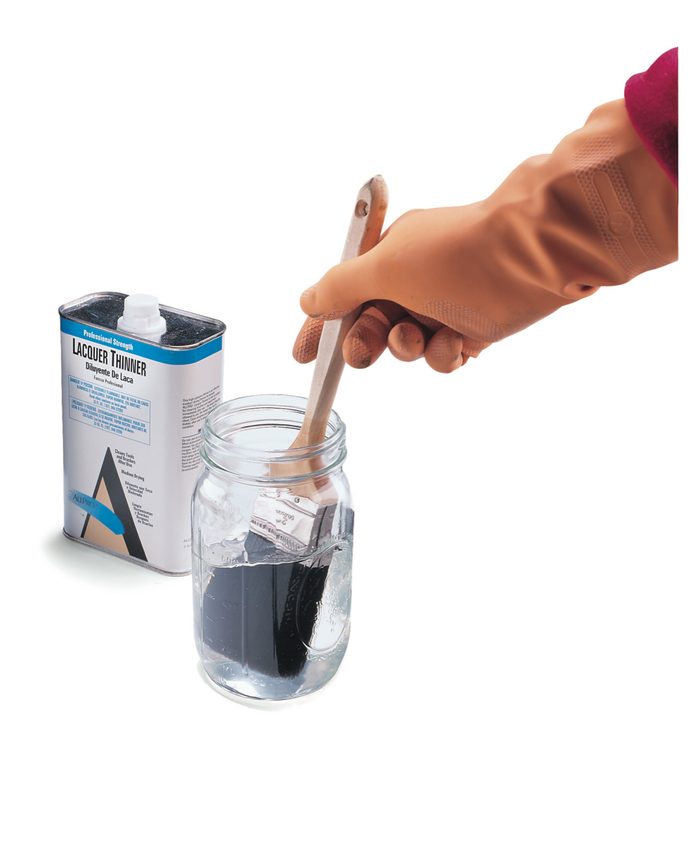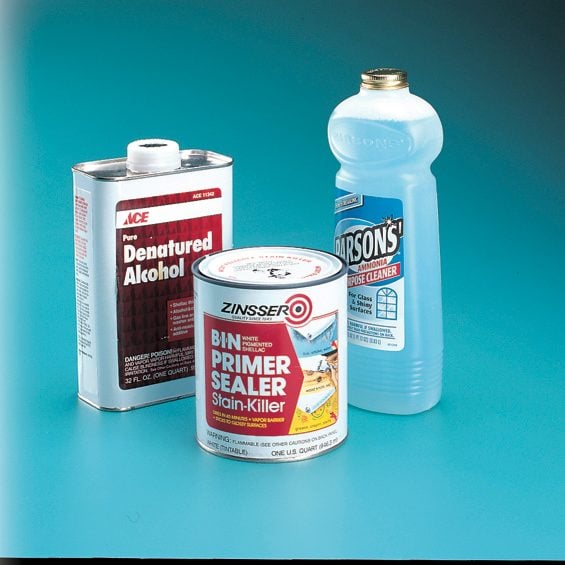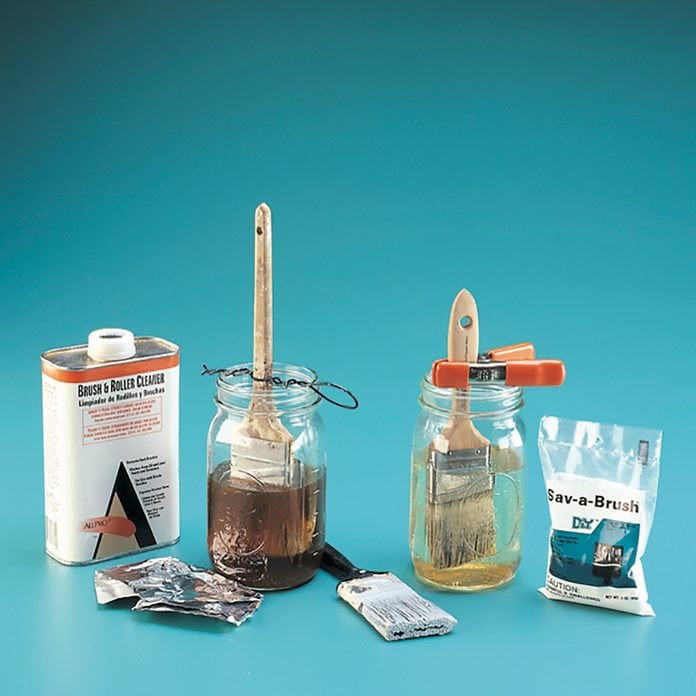How To Clean Latex Paint Off Brushes
How to Clean Paint Brushes
Cleaning tips for pigment brushes, whether y'all're using latex-, oil- or shellac-based paint.
![]() Time
Time
A few hours
![]() Complexity
Complexity
Beginner
![]() Cost
Cost
$twenty-l
Introduction
Good paint brushes are worth the coin, whether you're painting with latex, oil or shellac. Here's how the pros clean up their expensive paint brushes. Plus, nosotros included some tips at the terminate for reviving your petrified paint brushes.
Tools Required
Materials Required
- Denatured alcohol
- Household ammonia
- Lacquer thinner
- Newspaper
- Paint thinner
A Good Pigment Job Starts With a Good Brush
One expensive paint brush is way improve than a handful of cheap brushes. Get a good nylon or polyester brush for painting with latex and a good natural (animal hair) bristle brush for oil paints. Don't use a natural-bristle brush for water-based paints like latex. The natural fibers volition smashing, lose their shape and eventually lose their strength, besides. If y'all tin't get the buying data you lot need from a dwelling house center or hardware store, go to a retail paint store for assist.
Project step-by-step (xiv)
Stride i
Cleaning Water-based Finishes & Latex Paint From Brushes
Scrape Off Backlog Pigment
- Use the rim of a can then piece of work some of the paint onto newspaper before cleaning in soapy water.

Step 2
Launder the Brush In a Pail of Soapy Water
- Work the paint gratis of the bristles with your hands and a castor comb.

Pace 3
Spin the Castor In a Pail
- Remove any remaining paint and water.
Spin flammable solvents only in well-ventilated areas away from furnaces, pilot lights and electrical devices of all kinds. Outdoors is all-time.

Step 4
Rinse the Bristles In a Pail of Clean Water
- Work the bristles with your hand. After a few minutes, spin the brush once more and and so rinse it in another pail of make clean water.

Step v
Wrap the Castor With Heavy Paper
- Pre-fold the paper every bit shown, then wrap information technology effectually the brush and necktie it loosely with cord.
- Pro Tip: This pace is critical to retain the shape of the castor

Step vi
Cleaning Oil-based Varnishes & Paint From Brushes
When learning how to clean oil paint brushes always work in a well-ventilated surface area when cleaning brushes in solvents such as paint thinner, lacquer thinner, booze and ammonia. In fact, it'south best to work exterior. Don't ever clean solvent-laden brushes around h2o heaters, stoves or any device with an open up flame or potential electrical spark. Keep the solvents in proper, well-marked containers out of accomplish of children and pets.
Step 7
Rinse the Brush Thoroughly in Paint Thinner
- Work the bristles with your hands
- Pro Tip: Wear chemical-resistant gloves, which are available at your hardware shop or home center.
- If necessary, employ a brush rummage to get rid of paint clinging to the castor.
- Note: This is less of a problem with oil paint than with latex.

Step viii
Spin the Brush for x Seconds
- Apply a castor-and-roller spinner after nearly all the paint solids are out of the castor.
Step nine
Dip Castor Into Make clean Paint Thinner
- Work whatever remaining pigment out of the bristles.
- Pro Tip: Agitate the bristles for at least two minutes.
Step 10
Spin Brush a Second Fourth dimension
- Use a brush-and-roller spinner
Step 11
Dip in Lacquer Thinner
- Arouse the brush for about a infinitesimal to remove whatsoever remaining paint residuum;
- Shake the brush onto newspaper to remove the lacquer thinner and rest.
Lacquer thinner is extremely flammable—be sure to practice this outside.

Step 12
Clean the Brush in a Bucket of Soapy Water
- Apply laundry or dish soap. Work the bristles for just one minute.
- Note: Purists may not want to practise this, particularly with natural-bristle brushes, simply a quick cleaning with water won't harm the bristles.
- Spin the brush free of water and then shape the brush as shown higher up.
Pro Tip: Don't dump the pigment thinner when you're finished. Allow the paint solids settle to the lesser of the jar, and then pour off the rest into a make clean container. Let the solids dry outdoors and so dump them in the trash for landfill or hazardous waste. Call your local trash service for proper disposal.
Step 13
Cleaning Shellac-based Paint From Brushes
Cleaning clear shellac varnish or pigmented shellac paints requires a unlike solvent than does latex and oil. You must use denatured alcohol or an ammonia household cleaner.
When using an ammonia solution:
- Mix it with warm water at twice the strength recommended for cleaning floors;
- Rinse the brush in lukewarm water, and spin and wrap it (every bit shown above);
- When using denatured alcohol, follow the aforementioned steps every bit for the oil-based paint cleanup, but employ booze instead.

Stride 14
Reviving Petrified Brushes
If yous find your paint brushes have petrified since the terminal time you used them, don't throw them abroad. You can buy either of the brush cleaners shown below to dissolve the crusty hard paint. However, choose advisedly.
- The solvent-based cleaner is bang-up for whatever brush (natural or synthetic);
- The water-based cleaner on the right is only good for synthetic brushes.
Both solvents volition remove hardened latex and oil-based paint. The brushes must soak overnight (embrace the container on the left with foil in a well-ventilated area). If the paint isn't softened after 24 hours, let the brushes soak another twenty-four hour period. You must append the brushes equally shown or the bristles permanently bend as they soften and settle into the bottom of the jar.
One time the bristles are supple, remove the castor and comb abroad any solids.
- If you're using the solvent-based cleaner, soak the brush once again for an 60 minutes in a clean solution to remove any more solids, then follow the procedure for cleaning oil-based paint from brushes.
- If using the h2o-based cleaner, launder the brush in soapy water and follow the directions for cleaning latex paint from a castor.

Originally Published: October 02, 2018
Source: https://www.familyhandyman.com/project/how-to-clean-paint-brushes/
Posted by: tylertolved1965.blogspot.com


0 Response to "How To Clean Latex Paint Off Brushes"
Post a Comment